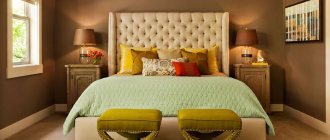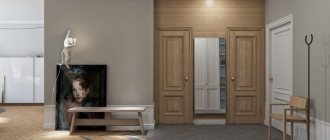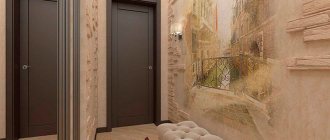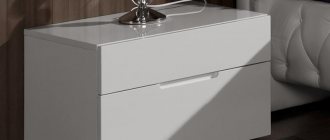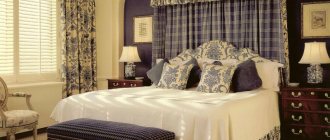Hallway
06/12/201602/25/2017 Olga Bilovitskaya
Many people, when making renovations, often do not pay attention to the interior of the hallway. They strive to make this room functional and forget that convenience can be combined with stylish design. Even the most modest hallway can be turned into a work of art by choosing the right design. So, what color should you paint the hallway in your apartment?
The role of color
Color is a key element of room design. The chosen shades depend on the style, lighting, area and purpose of the room. There are no strict rules in choosing colors for the hallway; the full scope for creativity is limited only by the designer’s imagination. The only thing that is recommended to be taken into account is that the interiors of the corridor and other rooms should be harmoniously combined.
The walls in the corridor can be painted in any color: bright, pastel, saturated and muted - it is recommended to avoid only white. Classic light brown and beige shades are suitable for those who want to create, above all, a practical corridor. Light gray walls will visually enlarge the room, and this color is easy to combine with brighter tones.
In any room, it is advisable to combine no more than three colors, otherwise the colorful walls will “overload” the interior. Before you paint the corridor, you need to think about whether the existing furniture will fit into such an interior. If you have the opportunity to purchase a new one, then maintain a single style. Classic furniture is unlikely to fit into a red or black corridor, and minimalist furniture into a pink one.
Important note! The furniture should be darker than the walls, but not too dark in color. Black should always be balanced with light shades.
The process of painting the hallway and its design (video)
Painting the hallway and its further decoration is a very exciting process, which can be handled without the help of specialized specialists. The main thing is to understand why all this was started and what result it is intended to bring. Then you simply won’t have to worry about the outcome of your undertaking.
What color to choose for the hallway?
Since hallways are most often small in size and at the same time they form the first impression of the home, you should approach the issue of their design carefully.
Factors to consider when choosing hallway color
Designers recommend considering the following factors:
- Room area. The light color of the hallway will visually expand the space. Dark colors conceal the area.
- Style. Many styles have certain color schemes, so use them.
- Form. Walls with vertical stripes will “raise” the ceiling, and horizontal stripes will lengthen the room. Striped wallpaper is often used for such purposes.
Popular styles and their associated colors
As mentioned above, the color in the hallway interior largely depends on the style of the room.
Let's look at the colors characteristic of popular styles:
- Art Nouveau (modern) and classic - sand, pastel and wood shades, white, green.
- Baroque and Empire - gold, white, red, turquoise, blue.
- Rococo – gold, pink, turquoise, cream, white.
- Minimalism – gray, black, white, as well as pastel colors.
- High-tech – metallic shades, white, black.
- Fusion - characterized by non-standard color combinations - bright pink and golden, rich light green and muted pastel tones.
Is white color appropriate?
The main color of the hallway in the apartment can be white. But this solution is rarely used, even if white suits all the parameters. It's not practical.
Guests crowd in the hallway, leaving their shoes and outerwear, sometimes wet after the rain. Therefore, over time, the coatings will lose their whiteness, and any abrasions will be very noticeable.
A good alternative to white is ivory. The shade is rich, goes well with many colors and looks presentable.
Gray hallway
Unlike white, gray is much more practical and its advantages do not end there. This color includes many shades - the color of asphalt, metallic, pearl. Such scales have a positive effect. They relax and relieve tension. However, a gray hallway, where gloomy shades predominate, can be depressing and cause boredom.
It is recommended to give preference to light shades of gray, which will make the room airy, fresh and spacious. Textured surfaces add variety to the interior of a gray hallway. The texture can be created using decorative plaster.
Options for color combinations in the hallway
Color combinations can be divided into several categories:
This is the optimal choice for those who want to decorate the interior in one color spectrum, and at the same time want the decor to be expressive. An example of using similar colors is classic green, light green, turquoise, olive, bright lime.
When deciding to use similar colors, designers still recommend adding tones, at least in the form of inclusions, from other spectrums.
An interesting and bold solution that should fit into the overall decor of the hallway.
It will be useful: Do-it-yourself panels from scrap materials: from stones and balls, from foamiran, a master class from cones and metal
Options for using contrasts:
- Floor and walls; floor and furniture; walls and furniture; floor, walls and door.
- Small interior elements or decor that contrasts in color with the main color scheme.
- Bright, rich patterns are set against a background of muted tones.
Design and color of wallpaper in the hallway
Wallpaper designs are:
This color of the walls in the hallway will not distract attention and will allow you to focus it on other interior items, for example, on decorative elements. Plain wallpaper looks laconic and does not overload the eye. If the color of the wallpaper in the hallway is gray or pastel, it will complement minimalism, and metallic shades will emphasize hi-tech.
We already mentioned the stripe effect in the first section. We would like to add that the stripes should not be too contrasting and expressive in order to avoid the well effect.
Abstract patterns come in a variety of forms, from easy-to-understand shapes to intricate patterns that can produce interesting visual effects (rotating circles, protruding squares). You should refrain from the second option, since psychological comfort in the room is important and not all residents will like this solution.
Easy-to-understand forms should be combined with the style of the interior. For example, some directions are characterized by geometry, while others are characterized by smooth shapes and lines. The background and patterns should not be too contrasting in hallways with a large wall area.
Textured wallpaper imitates many materials - wood, stone, marble, brick, plaster. There are also exotic options - imitation animal skins or tribal huts. This solution allows you to complement the interior style, whatever it may be, except for options when you need to implement minimalism using plain and smooth wallpaper.
Hallway floor color
Perhaps many people believe that the most optimal floor color in the hallway is dark. It is non-staining and practical, and there is some truth in this. However, high-quality floor finishing materials can be abrasion-resistant and durable. Therefore, designers successfully use not only dark colors, but also lighter tones, for example, if they need to implement a Scandinavian style.
We suggest considering design solutions for choosing the floor color for the hallway.
- For the floor of a small hallway, choose light and cool shades - blue, light blue, gray. Floor tiles made of gray and white squares will look very attractive.
- The spacious entrance hall gives free rein to the designer's imagination. A glossy black floor will contrast effectively with white walls and black and white furniture.
- Make the floor darker than the walls, and the ceiling should be at least a few shades lighter than the floor. In this way, the proportions of the room are visually preserved and the space is not hidden.
- If the walls are muted tones, then the color of the floor can be made bright and rich. For example, an orange floor is suitable for sand-colored walls.
- A glossy floor covering, especially in light colors, visually increases the space.
- The color of the floor should be different from the color of the furniture. Otherwise, the situation will be inexpressive. Something should be at least a few shades lighter. Contrast also looks impressive, for example, a dark floor and light furniture.
When choosing the color of the hallway, first of all, consider what you prefer - dynamic colors, the tranquility of the north, summer motifs or pastel shades that radiate calm. Based on this, decorate the hallway, because it will be the one that will greet you when you come home, in any weather and at any time of the year.
See more than 200 photos of hallway designs in various colors in our gallery →
Choosing a color for a narrow hallway
A narrow corridor seems inconvenient to many. Only place cabinets along the walls, which, by the way, are constantly getting dirty. Pasted wallpaper often breaks because it gets touched by bags and outerwear, so the best option is to paint the walls.
Article on the topic: Design of a corridor in an apartment (+50 photos)
A narrow corridor imposes certain restrictions on the selection of colors. The main rule is not to overload the corridor with an abundance of flowers.
It is important to make a narrow corridor well lit not only through lamps.
White would be an excellent solution, but its downside is impracticality. This does not mean that it cannot be used in the hallway at all. A snow-white finish on a burgundy or dark blue background will look very impressive. If you do not want such experiments, it is recommended to choose light and delicate colors. Pay attention to the cool color scheme, which will help create a feeling of airiness in the interior.
Avoid monotony, it will tire you. You can create a smooth transition from a light shade to a darker one throughout the entire corridor. Another solution is to create an interesting texture on the walls, such as plastering before painting.
What do you need to prepare?
Walls
The walls in the hallway are subject to active wear and tear, so potholes, stains, chips and smudges often appear on them. The work surface can be tidied up by removing old paint or wallpaper (if necessary), using a stiff brush and soap solution (a 3% soda solution is also suitable), and leveling with putties.
If you notice that the walls have become “infected” with fungal mold, then before applying the primer you need to treat the infected areas with special chemicals. means, and then remove the layer of dead fungi. If necessary, the procedure should be repeated.
Stages of preparatory work:
1. Putty the cleaned area. Gypsum putty is usually used for this.
2. Let the putty dry completely and apply a primer.
Putty and deep primer are required! Without them, all surface imperfections will appear under the paint, and the paint itself will lie unevenly, whitish areas will remain or the texture of the paint will not appear.
Dye
Choosing the right paint for a corridor is not an easy task, given the huge range of offers from manufacturers. We will look for “vandal-proof” according to the following parameters:
- budget;
- easy to clean;
- resistant to wear;
- elastic;
- moisture resistant;
- "breathable";
- safe;
- with a high degree of adhesion.
Article on the topic: Is it possible to plaster over paint: recommendations for preparing walls
These parameters are met by paintwork materials that combine the properties of interior and facade paints - enamels, glazes, two-component polyurethane, water-dispersion paints based on acrylic and latex.
Alkyd enamels are good, but you can only work with them with open windows and doors, because... when dry, they release a sharp pungent odor of coloring pigments, which persists for 3-5 days. There is an alkyd with polyurethane without such odors, but its prices are steep.
A washable water “dispersion” is perfect for painting walls in the hallway.
Acrylic styrene paints are also suitable for solving the problem of changing the color in the corridor. The best option in this series is butadiene dispersion for interior work.
All these paints offer many texture options: from matte glossy or shiny varnish to the effect of wet silk or soft velor.
Having finished selecting paint according to its properties, do not forget to stock up on brushes, rollers, a spray gun (according to the application technique), masking tape (for even separation of painted surfaces) and stencils if desired.
Decoration for a small hallway
Small rooms require a particularly careful design approach. What color should I paint the room? It is not recommended to make the walls in such hallways monochromatic. For visual expansion, it is recommended to use horizontal stripes. Vertical lines will correct low ceilings, visually lifting them. The pattern does not always have to be straight lines; a pattern directed horizontally or vertically is sufficient.
The color scheme in a small corridor should not be too dark. It is best to paint in light cinnamon and beige shades with white and off-white trim. An interesting solution would be white and brown striped teeth. A white horizontal stripe on the wall under the ceiling will visually raise it. You can also use mirrors and metal trim pieces to expand the space.
Small rooms are very capricious in terms of design. The emphasis should be on functionality, but at the same time avoiding exaggerated minimalism.
Natural materials look good in a small apartment. Light wood trim will create a warm and cozy atmosphere, and if installed correctly, it will last for many years.
Related article: Decorating a small hallway: selection of materials
Small room and color choice
A small room is always a difficult task for a designer, since the main thing is not to clutter up the space, to expand it as much as possible and defuse it, without resorting to actual changes to the enclosing structures and ceilings.
It’s interesting that a small hallway is not conducive to using a single color color. Here it is advised to choose lines, often horizontal - they expand visually and give more “air” to those entering.
Too dark a color scheme is not used. They turn to stylistic solutions that favor light. Beige and light shades of brown are actively used.
Decorating with natural materials
Walls covered with wooden panels in the hallway are still a rarity, but this bold decision looks very advantageous in corridors of any type. What effect can such walls create? Thanks to the variety of shades and natural structure of wood, you can create a unique interior.
Wood will not only decorate, but will help solve several problems. You won't have to level the walls because the panels will hide minor unevenness. The room will not need to be insulated, which is especially important in drafty hallways.
Natural materials look great in the right lighting. Wood needs warm, diffused light, while stone requires bright, directly incident rays.
An equally interesting material is stone. Of course, if you cover all the walls with it, it will look gloomy, but individual areas will blend harmoniously with the interior. It is better to choose the type of stone depending on what color you have chosen to paint the rest of the wall.
It is important to consider the style of the room. In classic and country style, wood would be appropriate, while modern, retro and minimalism gravitate more toward stone. If your interior is in high-tech style, then it is better not to use such finishing.
Painting walls in the hallway of an apartment photo examples
Arranging a hallway is an important and difficult task. It is necessary to make the room not only interesting and attractive, but practical and cozy. There are many decoration options and you can experiment with the finishes of the ceiling, walls, floor and add interesting accessories.
One of the ways to decorate a corridor is to paint the walls. How to paint the hallway in an original way and create an interesting design? I invite you to the group on Subscribe.ru: APARTMENT RENOVATION, USEFUL TIPS, HOME AND FAMILY
how to paint a hallway
Features of the room
It is important that the walls retain their attractiveness for a long time and delight with their design. Therefore, finishing materials are chosen taking into account the operating conditions of the room.
The proximity of the street leads to temperature changes in the corridor and high humidity, so the material must be resistant to these fluctuations and moisture.
Quite often you have to carry a lot of objects, sometimes large ones, through the hallway, so the walls should be protected with a finish with increased wear resistance that can withstand impacts and other mechanical loads.
In addition, wall coverings must be environmentally friendly, free of harmful impurities, create a good microclimate in the room, and also withstand numerous cleanings and washings well.
Painting methods
- They directly depend on the configuration of a particular hallway. However, there are basic design rules with the help of which it is possible to optimize a room, disguise its shortcomings and play up its advantages.
- Light colors. Our corridors are most often narrow and long without natural light sources. Therefore, wall coverings are chosen in light shades, which visually expand the space. The preferred shades are from beige, sand, yellow, golden to coffee.
- Reflective surfaces also make walls appear larger. By choosing a paint that gives a glossy surface, we will increase the light from lighting fixtures and visually raise the ceiling.
- Doorway design. If the corridor is narrow, the door at the far end should be painted a dark color. This contrast expands the hallway.
- You can highlight not only doorways, the front door, but furniture and mirrors by painting them in a bright color.
- With the help of glass wallpaper for painting, you can give the walls a texture that decorates the surface.
- Using stencils, you can get a unique hallway interior. Stencils are sold in many stores in a wide range: silhouettes of animals, birds and butterflies, floral and plant weaves, abstract ornaments. Ways to paint walls in an apartment with stencils? You need to work with stencils carefully and correctly match them to the overall design of the room.
- For an exclusive interior, you can entrust the design to an artist who will fulfill your wishes and make any fantasies come true.
- A winning and economical way: paint all surfaces of the corridor from floor to ceiling and even the furniture in the same color. This will help refresh the furniture and give the corridor a minimalist atmosphere.
Of course, the decoration of the corridor is determined in each specific case, depending on the shape and size of the room, the lighting and the number of doors.
strip in the hallway
Combination
Using different colors to paint walls is a very advantageous way to create an unusual interior. There are a lot of ideas for this type of painting and you can always choose the right option for your hallway.
- Dividing the walls into two levels. This method visually somewhat lowers the height of the room, but moves the walls apart, increasing the volume. Most often, a light and dark shade of the same color is chosen. However, cold and warm colors combine interestingly. The lower part of the wall is usually painted in a rich color, and the top in a lighter color. Wallpaper the walls in the hallway or paint the walls? It is much more effective to add artificial stone or wood panels to a light level of the wall.
- A wall with multi-colored stripes looks unusual and attractive. The strips can have different widths and run parallel to the floor. In this method, the colors of the stripes can be anything, the main thing is not to allow any color to stand out - otherwise it will quickly get boring.
- A common option is to combine paint and decorative plaster. It allows you to simply decorate a corridor, turning your imagination into a beautiful design. Special spatulas make it possible to obtain decorative plaster with various grooves, streaks, waves, and abstract patterns.
- Using different shades, you can divide the hallway into functional zones. For example, paint the area with the mirror and cabinets more brightly.
What color combinations are traditional? These are black and white, light beige and darker sand, blue and milky, turquoise and copper.
what color to paint the hallway
So, how to paint the hallway with your own hands?
When starting to paint walls, you should follow the sequence of work.
Remove old covering. The paint is removed with a spatula, scraper or special compound. Wallpaper in difficult places is moistened with water before removing from the wall.
The weak surface layer is removed and plastered again, then the walls should be puttied and sanded after drying.
After sanding, you need to sweep away the dust first with a broom, and then thoroughly vacuum and treat the walls with acrylic primer twice. The primer strengthens the surface, improves adhesion to paint and saves material consumption.
Cover all adjacent areas and necessary boundaries with masking tape.
Apply the first coat of paint with a brush after the primer has dried. It is better to apply the second and third layers with a roller.
Now we know how to paint a hallway with our own hands, what color to choose, how to competently make repairs to get an unusual design. Good luck to you!
If you find an error, please select a piece of text and press Ctrl+Enter.
Additional Information:
- Lining. Painting kitchen walls with water-based paint photo? A natural, aesthetically attractive and practical design option. The lining retains its original appearance for a long time; such wall covering is unpretentious in maintenance and installation.
- MDF wall panels. These composite models can have different colors and textures. MDF boards or panels in the interior of the corridor will look very beautiful and will add a special atmosphere to it.
When decorating a hallway with natural material, it costs more effort; it is more difficult to lay out, but the finished version creates a unique interior. It is distinguished by its strength, moisture resistance and practicality. In addition, the use of eco-friendly materials is popular today; wood, rocks, cork, and metal are often used.
The functional load of the corridor cannot be compared with its area. The hallway is not only an “intermediate room” “from the living room to the kitchen,” but also a place where they undress after coming home from the street, hang jackets or coats, store outerwear and shoes, keys, umbrellas, mail, shoe care products …. And what’s even more important is that they greet and see off guests.
Therefore, the room should be not only functional, but aesthetic.
Stippling is very popular in design circles - aging a freshly painted surface. To do this, you just need to cover the wall with the paint you like, and then use a round brush and glaze to create a random texture. If you decorate old furniture in the same way, you will end up with a whole vintage composition.
How to choose the right color for the walls in the hallway? There are simply no specific rules, because there are so many options. The final choice of color and texture of the walls depends on the size and lighting of the hallway, layout and theme, functionality and general style of the interior of the house.
The best option in this situation is to work through design projects and visualization, so you can create several suitable design options.
High-tech - the base is the color “silver metal”, the background is various shades with a metallic sheen. A rich color palette will allow you to create the perfect hallway, where your wishes and interior design rules will be taken into account. Experiment and enjoy the result.
Backlight
Lighting is used to zone rooms or create accents on certain details. A place with mandatory enhanced lighting is next to the mirror. You can experiment with other areas of the corridor.
Colored lighting in a hallway with plain walls will create a completely different mood. And the color of the lamp is easy to change if desired.
The color of the light source also plays an important role. Green is best used in the relaxation area, golden or pinkish in front of the mirror. Cool tones visually expand the rooms. Movable lighting fixtures will create an interesting effect in any functional area.
Before choosing what color to paint the hallway, you need to take into account all the functional features so that the color scheme improves the appearance of the hallway. A good hallway interior is very important because it sets the mood when you enter your home.
Related article: Interior of a long corridor - planning a narrow space
Hallway in white and brown tones (2 videos)
Color options for the hallway (38 photos)
Which paint to choose
The hallway is a room with its own microclimate, wet cleaning is carried out in it and the settling of dirt is increased, therefore the choice of a waterproof dye is required. This requires a non-toxic, human-safe option.
With patterns
Paints recommended for use in the corridor:
- Acrylic. High durability, long service life, long successful presence on the market - this is about acrylic. It is recommended for painting work on any surface and is relevant for most rooms. The hallway is no exception. The paint has a wide color palette and varieties (fluorescent, pearlescent).
- Polyvinyl acetate. The dye's durability is low, it does not tolerate water well, and mechanical damage destroys the coating. It is distinguished by a bright palette, for which it can be used. The most unpopular of the options listed.
- Construction butadiene. This aqueous dispersion is resistant to wear, steam, and water. The product has bright colors in a palette suitable for creating a design in the corridor.
How many colors to use as much as possible?
The question of the number of colors in the design is considered together with taking into account the parameters of the geometric correctness of the hallway, the width and height of the enclosing elements, and their dimensions.
A small room can be well divided into zones using two or shades of the same color (it is acceptable to play with tones).
Interesting! Techniques like stripes visually expand space in one dimension and narrow it in another. This is optimal for straightening out irregular shapes. The width of the stripes also affects the strength of the effect.
The standard zoning for narrow rooms is to paint the top of the wall in a light shade and the bottom in a dark shade. The joint is formed by a plinth or false column.
A wide hallway allows the use of more than two shades. Here you can fully divide the room using color - the threshold part, the corridor, the entrances. Zoning is also carried out in relation to the installed furniture - for example, a closet, a table, a shoe rack, etc.
Example
It's important to have some color skills before on your own choosing a specific color set with no limited quantity. Without this, you can really overdo it, the room will become visually disassembled into parts, and it will only be possible to put it back together with new finishing, which is costly and time-consuming.
Stripes
How to decorate the hallway
The hallway is also a corridor room, but besides this, any hallway is the face of the entire apartment or house. This is where guests and casual visitors come, depending on how cozy and equipped it is, the first impression of the owners is created. The walls of the hallway must be finished with moisture-resistant materials and those that are easy to clean, since all the dirt and moisture from the street is brought in here. The hallway walls are finished with:
- Washable wallpaper;
- Various moisture-resistant paints;
- Plastic panels.
The color of the walls in the hallway can be any, but it is better not to choose too light colors to avoid rapid contamination of the surface, which will create an unpresentable appearance.
What determines a positive result?
Achieving success based on a single selection is unrealistic. It is necessary to take into account a wide range of factors influencing the selection of color and the dyeing process.
The parameters taken into account are:
- Size. The dimensions of the hallway depend on the developers' plans for the premises; there are options that are cramped, spacious, elongated, with high ceilings. Color has the ability to visually change the real state of things. A competent colorist will accurately name the main taboos in this matter. So, for example, the idea of painting a cramped room in light-absorbing black is a failure - small rooms are decorated in light colors.
- Form. This is especially true when there are two colors that can actually be given different tones. The shape of the rooms is square, rectangular, with beveled corners, irregular (they have many columns, distorting elements).
Attention! Especially elongated shapes are emphasized with color rather than leveled. The smaller surface is painted dark, the larger surface light. This creates the effect of a long corridor; it is not always suitable, but often looks better.
- Number of doors. Openings complicate the work and make it impossible to use some finishing options in the hallway. When developing a design project, quantity is taken into account.
- Lighting. The presence of lamps in the hallway affects the perception of color in the decoration. Abundant lighting does not make it possible to use dark colors in small rooms, but it allows for patterns and other unique options.
It is necessary to learn how to conduct a thorough analysis of the premises from the actual state of things. Smart decisions made on the basis of such an analysis will help brighten up the shortcomings and emphasize the advantages of the hallway. Without this, success is not expected from painting; there is a high risk of developing a failed project.
How to choose the right floor in the hallway
When choosing what color to paint the walls in the hallway, you should take into account the color and material of the floor. The following materials are usually chosen as flooring for a corridor or hallway:
- Linoleum;
- Ceramic tiles;
- Laminate.
Ideal floor for a hallway
Linoleum is suitable for flooring, both in the corridor and in the hallway. It is inexpensive, durable, moisture resistant, and easy to lay on your own. Linoleum is easy to clean, which is important for a hallway. Any wall decoration will be combined with linoleum, the main thing is to choose the right shades.
Ceramic tiles are often installed in hallways; they are abrasion-resistant, not afraid of moisture and are easy to care for; one drawback is their fragility. Do not drop various objects onto a ceramic tile floor, as this will easily damage it. Plastic panels and MDF panels in suitable shades will look good with ceramic tile floors.
It is better to lay laminate in ordinary corridors; it is not very suitable for hallways, as it is afraid of high humidity. If water gets into the grooves of the laminate, it becomes deformed and deteriorates irrevocably. Wallpaper and painted walls are perfect for laminate. This flooring gives the room coziness and warmth.
